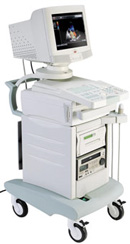Medical Ultrasound Imaging
Friday, 17 May 2024
'Frequency' p20 Searchterm 'Frequency' found in 161 articles 10 terms [ • ] - 151 definitions [• ] Result Pages : •
Efficiency is defined as the ratio of the acoustic power generated to the total electrical power input. Efficiency varies with frequency and is expressed as a percentage.
• View NEWS results for 'Efficiency' (2). •
The usual applications of endocavitary echography (also called internal echography / endoscopic ultrasound (EUS)) are examinations of the pelvic organs through internally introduced probes, which give a more precise and correct image. Transrectal ultrasound is a well established method for rectal or prostate carcinoma assessment. A transvaginal echography uses a small transducer that is inserted directly into the vagina. Used are high-frequency (10-12 MHz) for superficial organs, endocavitary echography, and intraoperative laparoscopic ultrasound. A sterile cover is slipped over the probe, which is then covered with lubricating ultrasound gel and placed in the cavitary (see Equipment Preparation). See also Endoscopic Ultrasound, Prostate Ultrasound, Interventional Ultrasound, Transurethral Sonography, Vaginal Probe, Rectal Probe. •
(EUS) Endoscopic ultrasound uses a small probe that is inserted in the rectum either through a proctoscope or by itself. During the test biopsies of any suspicious areas are possible. The usual necessary preparation is an enema to empty the rectum. Endoscopic ultrasound provides additional information about rectal polyps, rectal cancer, perianal infection, and sphincter muscle injuries and improves the selection of patients for local excision. Transrectal echography using a high-frequency transducer is a well established method for preoperative rectal carcinoma assessment. Endoscopic scanning is limited by the ultrasound physics (depth and axial resolution) of the endocavitary probe. Therefore, the combination of endoscopic and transcutaneous ultrasound is most favorable. •
Environmental protection in ultrasound imaging involves adopting practices and technologies that minimize the environmental impact associated with the use of ultrasound equipment and disposables. Here are some key considerations: •
Energy Efficiency: Opt for energy-efficient ultrasound machines and equipment that are designed to minimize energy consumption. This helps reduce the overall environmental impact associated with power usage. •
Digitalization and Paper Reduction: Embrace digital imaging and archiving systems to reduce reliance on paper. Storing images and reports electronically minimizes paper consumption, printing supplies, and physical storage space. •
Waste Management: Implement proper waste management practices for ultrasound-related disposables, such as ultrasound gel bottles, probe covers, and cleaning materials. Follow local regulations for the disposal of medical waste and prioritize recycling and responsible disposal methods. •
Equipment Lifespan and Disposal: Choose ultrasound equipment known for its durability and longevity. Maximizing the lifespan of equipment reduces the frequency of replacements, minimizing electronic waste generation. When disposing of old equipment, ensure proper recycling and disposal in accordance with local regulations. •
Education and Awareness: Promote education and awareness among ultrasound professionals about environmentally conscious practices. Encourage staff to adopt energy-saving habits, such as turning off equipment when not in use, and emphasize the importance of responsible waste management. Develop standardized and optimized examination protocols to minimize the duration and number of ultrasound scans required per patient. This helps reduce the energy consumption associated with prolonged imaging sessions and decreases the overall environmental impact. By focusing on energy efficiency, digitalization, waste management, equipment lifespan, and education, healthcare facilities can make significant strides towards reducing their carbon footprint and the environmental impact of ultrasound imaging practices. See also Ultrasound System Performance, Equipment Preparation, Ultrasound Accessories and Supplies and Sonographer. •  From Biosound Esaote, Inc.;
From Biosound Esaote, Inc.;'The Caris Plus combines the power of a conventional mainframe ultrasound system with an extraordinarily portable design. The result − High-performance ultrasound diagnostics in the most compact, most portable CFM system available anywhere. Powerful state-of-the-art microelectronics and wide-band multi-frequency technology ensure exceptional 2D, Doppler and CFM performance that can be taken where they're needed.' Specifications for this system will be available soon. Result Pages : |
Medical-Ultrasound-Imaging.com
former US-TIP.com
Member of SoftWays' Medical Imaging Group - MR-TIP • Radiology TIP • Medical-Ultrasound-Imaging
Copyright © 2008 - 2024 SoftWays. All rights reserved.
Terms of Use | Privacy Policy | Advertise With Us
former US-TIP.com
Member of SoftWays' Medical Imaging Group - MR-TIP • Radiology TIP • Medical-Ultrasound-Imaging
Copyright © 2008 - 2024 SoftWays. All rights reserved.
Terms of Use | Privacy Policy | Advertise With Us
[last update: 2023-11-06 01:42:00]




